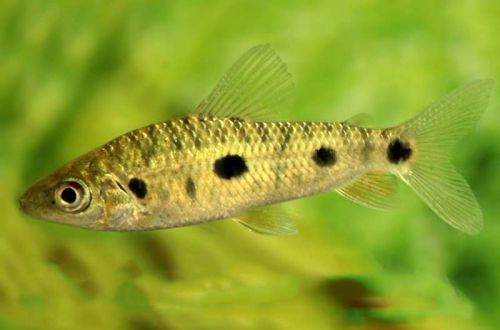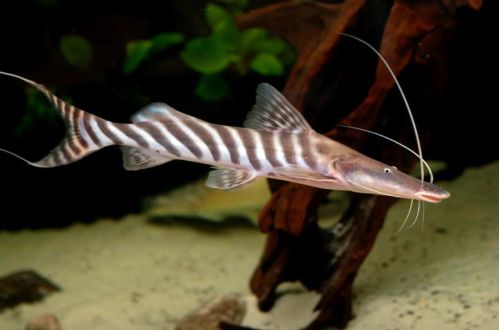
Akara Maroni
Akara Maroni or Keyhole Cichlid, scientific name Cleithracara maronii, belongs to the Cichlidae family. Not too expressive coloring, but peaceful disposition and simplicity in content determined the role of the “second plan” for this species. Usually these fish are used in community tanks as an addition to other more colorful neighbors. They are also worth paying attention to novice aquarists in order to gain initial experience.

Contents
Habitat
It originates from South America from the territory of modern Guyana, Suriname and Venezuela in the Orinoco Delta and the island of Trinidad. It lives in numerous slow-moving rivers and streams flowing through the rainforest. The bottom of reservoirs, as a rule, is littered with fallen leaves, branches, fruits of trees. The abundance of organics colors the water in a rich brown hue due to the high concentration of tannins.
Brief information:
- The volume of the aquarium – from 80 liters.
- Temperature – 21-28°C
- Value pH — 4.0–7.5
- Water hardness – soft to medium hard (2-15 dGH)
- Substrate type – sandy
- Lighting – any
- Brackish water – no
- Water movement – light or moderate
- The size of the fish is 7–11 cm.
- Meals – any
- Temperament – peaceful
- Content in a pair or group
Description

Adult males reach a length of about 11 cm and have more pointed dorsal and anal fins, unlike females, which are also noticeably smaller, only 7 cm. The color is light gray with a yellow or orange tint. The body pattern has a dark spot located above the lateral line under the dorsal fin. A characteristic feature is an oblique vertical strip passing through the eye, and shaped like a keyhole.
Food
Accepts most popular commercial aquarium fish foods. If desired, you can cook your own food from fresh products. For example, one of the recipes involves the use of a mixture of grated shellfish meat, shrimp, vegetables and fruits through a fine grater. All ingredients are mixed with gelatin and rolled into a strip. After hardening, cut into thin disks and serve the fish.
Maintenance and care, arrangement of the aquarium
The recommended volume of the tank for one pair of fish starts from 80 liters. The design is arbitrary, but Akara Maroni will look most harmonious in an aquarium resembling a natural habitat, and this is: a sandy substrate with several flat stones, numerous driftwood and thickets of plants. Unlike its relatives, this species is not prone to damage to vegetation, so it is quite acceptable to use not only artificial, but also living plants.
Sufficiently high requirements are imposed on the quality and composition of water, the parameters of which should have mild and acidic dGH and pH values, respectively. The presence of a productive filtration system and the regular replacement of part of the water with fresh and timely cleaning of the soil are a prerequisite. It is worth noting that powerful filters often cause an internal current, which is not welcomed by fish that live in calm waters.
Behavior and Compatibility
A peaceful calm fish, although it belongs to territorial species, adults form pairs and stay in a certain area. Akara Maroni gets along well with his relatives and other fish of a similar size and temperament from among the haracins, South American cichlids, Corydoras catfish and many others.
Breeding / breeding
Quite easy to breed, to obtain offspring there is no need to create special conditions. The only requirement is timely maintenance of the aquarium and, accordingly, good water quality.
Adult male and female form a permanent pair, which persists even at the end of the mating season. The spawning place is a flat stone, a wide leaf of a plant or glass, where the eggs are attached with a sticky substance. Females remain near the masonry for protection, and the male protects the boundaries of his conditional possessions. Parental care continues after the fry appear and can last for several months. It is worth noting that young inexperienced pairs will often eat their first brood, especially if they feel threatened by other fish.
In a densely populated aquarium, the probability of the death of offspring is high, even if there is such protection in the face of a female and a male, so it is advisable to spawn in a separate tank.
Fish diseases
The main cause of most diseases is unsuitable living conditions and poor-quality food. If the first symptoms are detected, you should check the water parameters and the presence of high concentrations of hazardous substances (ammonia, nitrites, nitrates, etc.), if necessary, bring the indicators back to normal and only then proceed with treatment. Read more about symptoms and treatments in the Aquarium Fish Diseases section.





